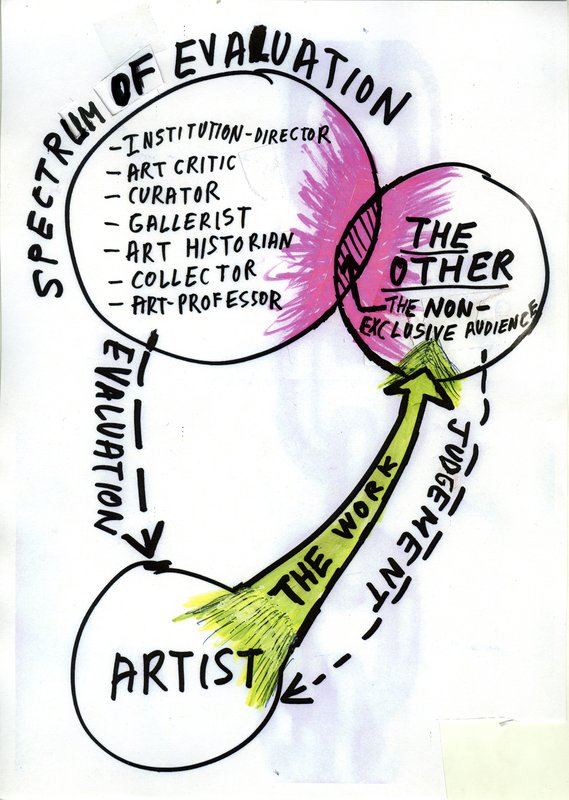“Spectrum of Evaluation” (2010) – [eng]
I made the “Spectrum of Evaluation” diagram for myself in order to clarify for whom I actually want to work; it is a plan for me so that I may orient myself. With this diagram I want to explain what, for me, constitutes the “non-exclusive audience.” The “non-exclusive audience” or the “non-exclusive public” is my own term, and I made this term so that I could, for once, define who the public for my work should be. I wanted to establish who I will be turning toward, in and through my work; I also wanted to make a clear statement against the “exclusive public” or the “exclusive audience,” AGAINST that which is “exclusive” in general. I continually read and hear the term “exclusive” used in art to argue, to intimidate, and to legitimize. I perceive that even in art, “exclusivity” has become a positive criterion. That can’t be, and that cannot go unanswered. I wish to counter it because art has nothing to do with exclusivity; ON THE CONTRARY, art is inclusive; art never excludes. In other words, the “non-exclusive public” is the opposite of a pre-determined, selected, and initiated public. As an artist, it is essential for me to work for a “non-exclusive public.”
Regarding my diagram and the circle that I have named “THE OTHER”: “The other” is the one who is unknown, the neighbor, the next person, the foreigner, the person who is hostile to me, the person who frightens me, the uninvited, the person who appears unexpectedly, who happens to pass by, the unanticipated. “The other” is ALSO ALWAYS the one with whom I had not reckoned. I want to work for that person. This the reason for the thick arrow in the diagram, “THE WORK,” which goes from the artist to “the other.” That has to be the dynamic: from the artist to the other. I want to give my work to the other. By contrast, the dynamic should NEVER go from the artist to the “Spectrum of Evaluation.” It is essential that I, as an artist, am never located in the “Spectrum of Evaluation,” and it is crucial that I have my own position. That is why it is necessary that I have my own POSITION, entirely my own, perhaps indefensible, but MINE. I must have my own circle in the diagram.
As an artist with a work I am not “the other,” nor am I a part of the “Spectrum of Evaluation” or the “spectrum of evaluators.” As an artist, it is never my place to evaluate, and I never want to take part in the “spectrum of evaluators.” The “spectrum of evaluators” is comprised of those who know art, who absolutely love art—I assume so. In the diagram, I have noted seven professions, all of which have to do with art, and which are located in the “spectrum of evaluators” and collectively evaluate art. Not all seven of the professions are in the spectrum all at once—but still, at least in pairs they evaluate art. Those who are in the spectrum evaluate art together: they discuss, they consult, they analyze, they inform themselves, they argue, they exchange, and they COMPARE. But one can only evaluate and compare if one evaluates or compares comparable things. The artist receives the evaluation from the “spectrum of evaluators.” However, the artist can’t do anything with such “evaluations”; they don’t get him anywhere because the artist makes something INCOMPARABLE, and what he makes CAN’T BE COMPARED.
By contrast, what I, as an artist, get from “the other” is a JUDGMENT; my work is JUDGED, which is how it has to be. That is what I work for. I want to be, and must be, prepared for his JUDGMENT. It is never about judging a person; that is the important thing, the beautiful, cruel, and most definitive thing; it is what I need, what propels me onward, what agitates me, that with which I may confront myself, that which makes me think. A judgment is final. And because it is a judgment and not a comparison, it is always also an engagement with the person who is making it. It is a headless, thoughtless engagement. Receiving a judgment is unbelievably valuable; through and with my work, I want to create the preconditions for a judgment. To receive a judgment for something I make is a gift, a personal judgment that comes from the heart. In order for me to receive such a judgment, I must have my own circle in the diagram. I will only succeed if I am outside the “spectrum of evaluators.”
What is crucial in my diagram is the fact that the “Spectrum of Evaluation” OVERLAPS with the circle of the other; the core of the “non-exclusive audience” is located in this overlap. No one is excluded from my work, no one is excluded from being able to judge it. I do not wish to create a new or other exclusivity with my diagram; on the contrary, I want to exclude nothing. But as an artist, I think I must determine the dynamic, the line of force, or the DIRECTION OF IMPACT. That is the reason for this diagram.
[Translated from German by Kenneth Kronenberg.]

Thomas Hirschhorn
«Spectrum of Evaluation», 2008-2010
Private Collection
